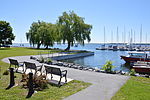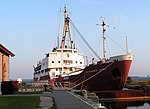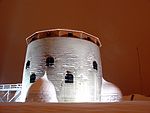Wolfe Island Wind Farm

Wolfe Island Wind Farm is a large wind farm project located on Wolfe Island, Ontario (near Kingston, Ontario). The wind farm became operational on June 29, 2009. It is owned and operated by Canadian Hydro Developers, Inc., through its subsidiary Canadian Renewable Energy Corporation (CREC). The power will be purchased by Hydro One for distribution to consumers. The wind farm consists of eighty-six 2.3-megawatt (MW) Siemens model Mark II wind turbines situated on the western portion of Wolfe Island.Once completed, the 197.8 MW project was expected to generate approximately 594 gigawatt-hours (GW·h) of renewable power annually; enough to supply about 75,000 average households. Over its first four full years of operation, generation proved to be around 495 GWh annually (see below). Winds of 3.5 to 4 metres per second (11 to 13 ft/s) are required to generate power; when winds are less than 3 metres per second (9.8 ft/s), then power is not being generated.
Excerpt from the Wikipedia article Wolfe Island Wind Farm (License: CC BY-SA 3.0, Authors, Images).Wolfe Island Wind Farm
4th Line Road, Frontenac Islands
Geographical coordinates (GPS) Address Nearby Places Show on map
Geographical coordinates (GPS)
| Latitude | Longitude |
|---|---|
| N 44.166666666667 ° | E -76.466666666667 ° |
Address
4th Line Road
4th Line Road
K0H 2Y0 Frontenac Islands
Ontario, Canada
Open on Google Maps










